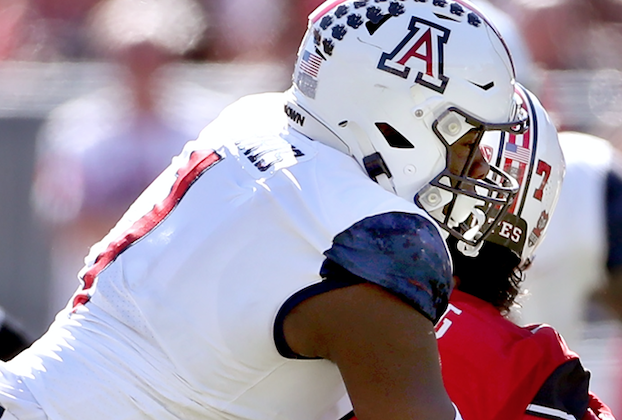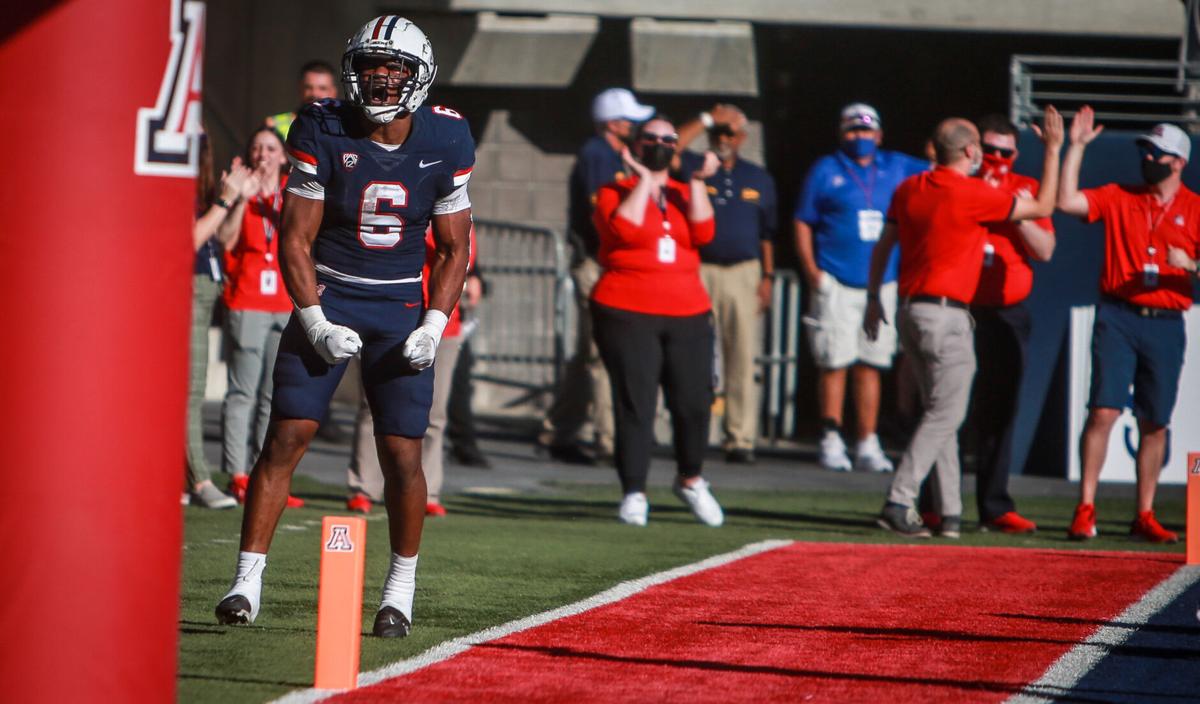The Star’s Michael Lev presents five storylines of interest as the Arizona Wildcats face Washington State on Friday night in Pullman. Kickoff is slated for 7 p.m. Tucson time. The game will air on Pac-12 Arizona:
‘Just playing my part’: RB Michael Wiley willing to do whatever he can to help Wildcats
Michael Wiley began the 2021 season as Arizona’s starting tailback. He received that assignment in each of the first three games.
But nothing in football is permanent. Wiley lost the ball against NAU and his starting job along with it. He played a secondary role, then a lesser one.
Lately? Wiley has played a critical part for the Wildcats. He scored the winning touchdown in the game that ended the program’s losing streak. He scored again the following week. And that 2-point play that could have tied the score against Utah? If it had worked, Wiley would have been the hero.
“We've always preached wanting to have guys that are great competitors,” UA offensive coordinator Brennan Carroll said amid preparations for Friday’s game at Washington. State. “And a great competitor, even if their reps are reduced at a certain point in time, they keep competing.
“We've seen, as the season’s gone on, the great competitors are still out there performing and playing. It all goes back to competition brings out the best in everybody. Wiley’s just another great example of that.”
Wiley, a third-year sophomore from Houston, hasn’t had the breakout campaign his 2020 stats suggested he might. He averaged 7.2 yards per carry last season and seemed poised to succeed Gary Brightwell as Arizona’s workhorse back.
But Wiley ranks second on the team behind Stanley Berryhill III with 453 scrimmage yards. Wiley also leads the Wildcats with four touchdowns.
None was more significant than the one he scored against Cal on Nov. 6. Wiley darted into the end zone from 10 yards out with 2:17 remaining. It was the only touchdown in a 10-3 UA victory that snapped a 20-game losing streak.
“Great feeling,” Wiley said. “I celebrated a little extra ... because I already knew our defense was going to go out there and handle their business, just like they did.”
Wiley said his main focus on the play was protecting the ball. The last thing he wanted to do was lose it and prevent Arizona from at least attempting the go-ahead field goal.
Wiley had lost two fumbles earlier in the season. In each instance – against NAU and UCLA – he didn’t play again after fumbling. Running backs coach Scottie Graham, who never fumbled during his NFL career, has little tolerance for turnovers.
Wiley assured his coach that he would redeem himself. Wiley also felt certain that he’d get additional opportunities to do so.
Even as other backs started in his place – first Drake Anderson, then Jalen John, then Stevie Rocker Jr. – Wiley remained steadfast. He has handled the ups and down of the ’21 season like a pro.
Wiley couldn’t have been happy about his role being reduced as Arizona integrated more backs into the rotation. Yet this was his response when asked about it:
“It’s just a part of the process. I got a new role being a third-down back. I just embraced that role so I can help the team. Just playing my part.”
Wiley matched Berryhill with four receptions vs. Utah last week, good for 48 yards and a touchdown. Wiley gained 32 yards on a throwback screen. It’s one of several trick plays he’s been involved in this season.
Arizona’s only touchdown against UCLA came on a pass from Jamarye Joiner – who was lined up as a receiver – to Wiley. The 2-point conversion attempt vs. Utah saw Berryhill pitch the ball to Wiley, who was supposed to throw a pass to quarterback Will Plummer. But the Utes defended the play well, forcing to Wiley to try to run it in. (He had no chance.)
Wiley’s involvement in those critical plays shows how much the coaching staff trusts him. They even have utilized him as “Wildcat” quarterback in recent games. It’s the first time, on any level, that he’s taken snaps from the center.
Those plays have been exclusively runs so far. If Wiley was asked to throw the ball, could he?
“Not as good as Will,” he said. “But yeah. I'm decent.”

Arizona wide receiver Dorian Singer fends off Utah safety Vonte Davis during the Wildcats' game against the Utes last week.
Unmasked Singer: Meet the freshman who’s emerged as a top target for Arizona
Over the past three games, only one Arizona receiver has more catches than freshman Dorian Singer – who, before the past three games, had none.
Only one receiver has played more snaps in those games than Singer.
In both instances, that player is fifth-year veteran Stanley Berryhill III, who leads the Wildcats in receptions and all-purpose yards. He’s unquestionably Arizona’s MVP.
Yet Singer actually has been targeted more times (21) in the past three games than Berryhill (20). Over the past two games, Singer leads the Wildcats in receptions (10) and yards (130).
Who is Singer, and how did he rise up the depth chart?
A product of St. Paul, Minnesota, Singer moved to Arizona in the summer of 2020 so he could attend and play for Pinnacle High School in Phoenix. Singer was rated as a three-star prospect, and in December he received the big offer he had been seeking.
It’s unclear why Singer didn’t end up at Texas, although a coaching change after he received his offer might have been the biggest factor. He committed to Arizona in early May, joining the program as a preferred walk-on.
In training-camp periods pitting freshmen and other young players against one another, Singer dominated. The coaching staff couldn’t help but take notice.
Singer continued to impress in practice as the season unfolded, even when working with the scout team.
“He had to embrace it,” UA coach Jedd Fisch said. “He had to understand where he was on the depth chart. He had to earn his way up every week.
“He got to the point (of), ‘How can we not play him?’ Then he had to start showing us that he knew what he had to do on every play. Not every play he gets right, but enough of them he gets right that he's worth playing.”
Singer made his debut on Oct. 30 against USC, catching three passes for 65 yards. He started the following week against Cal, posting a 5-46 line. Against Utah, he again caught five passes for a career-best 84 yards, including a 45-yard grab in the third quarter that led to a field goal.
“He's been doing it in practice,” offensive coordinator Brennan Carroll said. “Even though he was a scout-team player – and you can get your head down and think, ‘Well, maybe this isn't my year’ – he didn't do that. He did a fantastic job of performing. He's been making great plays.”

Jalen Harris was among of a number of Wildcats to sport new cat-paw stickers in last week's game against Utah.
Decal details: The story behind the Wildcats’ helmet stickers
The uniforms weren’t the only change to Arizona’s ensemble this past week.
While the Wildcats’ “Dress Whites” for Military Appreciation Day deservedly garnered most of the attention, some players also sported a slightly different look on their helmets.
Jedd Fisch and his staff have begun to reward players with helmet stickers if their performance warrants it. Defensive end Jalen Harris, for example, had 16 navy paw-print decals on the right side of his helmet against Utah.
With help from defensive line coach Ricky Hunley and others, Fisch researched how schools such as Ohio State and Michigan determine who’s sticker-worthy. Each unit has its own set of criteria. Players can earn them for individual or team accomplishments.
“Michigan was the only team I've ever been a part of that did helmet stickers,” said Fisch, who served on the Wolverines’ staff in 2015 and ’16. “We never did helmet stickers with any other team I was at. But I liked it. I liked the idea of it.
“On offense, we made criteria. On defense, we made criteria. On special teams, we made criteria. For example, you block a punt, the entire punt-block unit gets ... a helmet sticker. You get a win in the Pac-12, you get two stickers. You get a win (outside of) the Pac-12, you get one sticker. Some you get only if you win. And then some will be just based on individual accomplishments – a touchdown, interception, etc.”

Jedd Fisch has experience in cold-weather games. His players? Not so much.
Cold Fisch: WSU game won’t be first frosty affair for UA coach
The forecast for Pullman, Washington, on Friday night calls for temperatures in the mid-30s. For many Arizona players, it will be the coldest game they’ve ever experienced. Not so for UA coach Jedd Fisch.
Fisch was an assistant coach for Baltimore when the Ravens hosted the Green Bay Packers in a Monday-night game on Dec. 19, 2005. The temperature at kickoff was 29 degrees. The wind chill was 19.
The Ravens won 48-3 as Kyle Boller (three touchdowns) outdueled an aging Brett Favre (two interceptions). Wrote Jamison Hensley of The Baltimore Sun:
“On a numbingly cold night at M&T Bank Stadium ... the largest pro football crowd in the city's history (70,604) witnessed the most lopsided game in ‘Monday Night Football’ history, watching in disbelief as Boller's play couldn't get any hotter.”
Fisch also participated in a game played in the immediate aftermath of a blizzard. He was Minnesota’s offensive coordinator when the Golden Gophers visited Penn State on Oct. 17, 2009. The previous day, more than six inches of snow fell in State College, forcing tailgating to be banned in the grass lots around Beaver Stadium.
The temperature at kickoff of 37 degrees was the coldest on record for a Penn State homecoming game. The game started at 3:32 p.m. local time.
UA defensive tackle Kyon Barrs, who’s from Southern California, said he’d like to see “real snow” in Pullman. There’s a strong likelihood of precipitation there Friday, at least in the afternoon.
“I've never been in snow before,” Barrs said. “So that’s exciting.”
Washington State interim coach has (loose) connection to Arizona
Friday night will mark Jake Dickert’s first matchup against Arizona – and conceivably his last if he isn’t retained as Washington State’s coach.
The Cougars’ interim leader has coached at Arizona Stadium, however.
Dickert was the defensive coordinator at Wyoming when the Cowboys participated in the 2019 Arizona Bowl. Wyoming defeated Georgia State 38-17.
A little less than a month later, Dickert joined the WSU staff as defensive coordinator under first-year coach Nick Rolovich. Rolovich was fired last month, along with four assistants, for failing to comply with the state of Washington’s COVID-19 vaccination mandate.
WSU athletic director Pat Chun selected Dickert to serve as the Cougars’ interim coach. The 38-year-old had no prior head-coaching experience.
The WSU coordinator job was Dickert’s first in FBS. Here are all of his prior coaching stops, starting with Wisconsin Stevens-Point, where he played quarterback and wide receiver:
2007: Wisconsin–Stevens Point (graduate assistant)
2008-10: North Dakota State (GA/safeties)
2011: South Dakota (special teams/defensive backs)
2012: Southeast Missouri State (DB)
2013: Augustana (defensive coordinator)
2014–2015: Minnesota State (DC/linebackers)
2016: South Dakota State (safeties/ST)
2017–2019: Wyoming (safeties/LB/DC)








